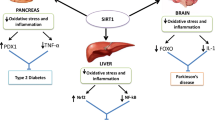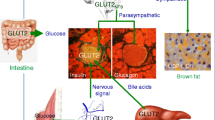Abstract
Background and Aims
The intestine demonstrates profound circadian rhythmicity in glucose absorption in rodents, mediated entirely by rhythmicity in the transcription, translation, and function of the sodium glucose co-transporter SGLT1 (Slc5a1). Clock genes are rhythmic in the intestine and have been implicated in the regulation of rhythmicity of other intestinal genes; however, their role in the regulation of SGLT1 is unknown. We investigated the effects of one clock gene, PER1, on SGLT1 transcription in vitro.
Methods
Caco-2 cells were stably transfected with knockdown vectors for PER1 and mRNA expression of clock genes and SGLT1 determined using quantitative polymerase chain reaction (qPCR). Chinese hamster ovary (CHO) cells were transiently cotransfected with combinations of the PER1 expression vectors and the wild-type SGLT1-luciferase promoter construct or the promoter with mutated E-box sequences.
Results
Knockdown of PER1 increased native SGLT1 expression in Caco-2 enterocytes, while promoter studies confirmed that the inhibitory activity of PER1 on SGLT1 occurs via the proximal 1 kb of the SGLT1 promoter. E-box sites exerted a suppressive effect on the SGLT1 promoter; however, mutation of E-boxes had little effect on the inhibitory activity of PER1 on the SGLT1 promoter suggesting that the actions of PER1 on SGLT1 are independent of E-boxes.
Conclusions
Our findings suggest that PER1 exerts an indirect suppressive effect on SGLT1, possibly acting via other clock-controlled genes binding to non-E-box sites on the SGLT1 promoter. Understanding the regulation of rhythmicity of SGLT1 may lead to new treatments for the modulation of SGLT1 expression in conditions such as malabsorption, diabetes, and obesity.









Similar content being viewed by others
Abbreviations
- Bmal1:
-
Brain muscle Arnt-like 1
- Cry:
-
Cryptochrome
- Mdr1:
-
Multidrug resistance 1
- mRNA:
-
Messenger ribonucleic acid
- Nhe3:
-
Na+/H+ exchanger
- Per:
-
Period
- PVDF:
-
Polyvinylidenefluoride
- SGLT1:
-
Sodium glucose cotransporter 1
References
Balakrishnan A, Stearns AT, Rounds J, et al. Diurnal rhythmicity in glucose uptake is mediated by temporal periodicity in the expression of the sodium-glucose cotransporter (sglt1). Surgery. 2008;143:813–818.
Hediger MA, Coady MJ, Ikeda TS, Wright EM. Expression cloning and cdna sequencing of the na+/glucose co-transporter. Nature. 1987;330:379–381.
Wright EM, Martin MG, Turk E. Intestinal absorption in health and disease—sugars. Best Practice Res. 2003;17:943–956.
Tavakkolizadeh A, Berger UV, Shen KR, et al. Diurnal rhythmicity in intestinal sglt-1 function, v(max), and mrna expression topography. Am J Physiol Gastrointest Liver Physiol. 2001;280:G209–G215.
Richards AM, Nicholls MG, Espiner EA, et al. Diurnal patterns of blood pressure, heart rate and vasoactive hormones in normal man. Clin Exp Hypertens A. 1986;8:153–166.
Selmaoui B, Touitou Y. Reproducibility of the circadian rhythms of serum cortisol and melatonin in healthy subjects: a study of three different 24-h cycles over six weeks. Life Sci. 2003;73:3339–3349.
Rohman SM, Emoto N, Nonaka H, et al. Circadian clock genes directly regulate expression of the na(+)/h(+) exchanger nhe3 in the kidney. Kidney Int. 2005;67:1410–1419.
Saito H, Terada T, Shimakura J, Katsura T, Inui K. Regulatory mechanism governing the diurnal rhythm of intestinal h+/peptide cotransporter 1 (pept1). Am J Physiol Gastrointest Liver Physiol. 2008;295:G395–G402.
Murakami Y, Higashi Y, Matsunaga N, Koyanagi S, Ohdo S. Circadian clock-controlled intestinal expression of the multidrug-resistance gene mdr1a in mice. Gastroenterology. 2008;135:1636–1644.e3
Hastings MH. Circadian clocks. Curr Biol. 1997;7:R670–R672.
Panda S, Hogenesch JB. It’s all in the timing: many clocks, many outputs. J Biol Rhythms. 2004;19:374–387.
Reppert SM, Weaver DR. Coordination of circadian timing in mammals. Nature. 2002;418:935–941.
Torra IP, Tsibulsky V, Delaunay F, et al. Circadian and glucocorticoid regulation of rev-erbalpha expression in liver. Endocrinology. 2000;141:3799–3806.
Preitner N, Damiola F, Lopez-Molina L, et al. The orphan nuclear receptor rev-erbalpha controls circadian transcription within the positive limb of the mammalian circadian oscillator. Cell. 2002;110:251–260.
Oishi K, Sakamoto K, Okada T, Nagase T, Ishida N. Humoral signals mediate the circadian expression of rat period homologue (rper2) mrna in peripheral tissues. Neurosci Lett. 1998;256:117–119.
Oishi K, Sakamoto K, Okada T, Nagase T, Ishida N. Antiphase circadian expression between bmal1 and period homologue mrna in the suprachiasmatic nucleus and peripheral tissues of rats. Biochem Biophys Res Commun. 1998;253:199–203.
Takata M, Burioka N, Ohdo S, et al. Daily expression of mrnas for the mammalian clock genes per2 and clock in mouse suprachiasmatic nuclei and liver and human peripheral blood mononuclear cells. Jpn J Pharmacol. 2002;90:263–269.
Sakamoto K, Oishi K, Nagase T, Miyazaki K, Ishida N. Circadian expression of clock genes during ontogeny in the rat heart. NeuroReport. 2002;13:1239–1242.
Balakrishnan A, Stearns AT, Ashley SW, Tavakkolizadeh A, Rhoads DB. Restricted feeding phase shifts clock gene and sodium glucose cotransporter 1 (sglt1) expression in rats. J Nutr. 2010;140:908–914.
Blais A, Bissonnette P, Berteloot A. Common characteristics for na+-dependent sugar transport in caco-2 cells and human fetal colon. J Membr Biol. 1987;99:113–125.
Martin MG, Wang J, Solorzano-Vargas RS, et al. Regulation of the human na(+)-glucose cotransporter gene, sglt1, by hnf-1 and sp1. Am J Physiol Gastrointest Liver Physiol. 2000;278:G591–G603.
Krasinski SD, Van Wering HM, Tannemaat MR, Grand RJ. Differential activation of intestinal gene promoters: Functional interactions between gata-5 and hnf-1 alpha. Am J Physiol Gastrointest Liver Physiol. 2001;281:G69–G84.
Fu L, Patel MS, Bradley A, Wagner EF, Karsenty G. The molecular clock mediates leptin-regulated bone formation. Cell. 2005;122:803–815.
Zheng B, Albrecht U, Kaasik K, et al. Nonredundant roles of the mper1 and mper2 genes in the mammalian circadian clock. Cell. 2001;105:683–694.
Bae K, Jin X, Maywood ES, et al. Differential functions of mper1, mper2, and mper3 in the scn circadian clock. Neuron. 2001;30:525–536.
Balsalobre A, Damiola F, Schibler U. A serum shock induces circadian gene expression in mammalian tissue culture cells. Cell. 1998;93:929–937.
Kowase T, Walsh HE, Darling DS, Shupnik MA. Estrogen enhances gonadotropin-releasing hormone-stimulated transcription of the luteinizing hormone subunit promoters via altered expression of stimulatory and suppressive transcription factors. Endocrinology. 2007;148:6083–6091.
Moon YS, Latasa MJ, Griffin MJ, Sul HS. Suppression of fatty acid synthase promoter by polyunsaturated fatty acids. J Lipid Res. 2002;43:691–698.
Berberich C, Durr I, Koenen M, Witzemann V. Two adjacent e box elements and a m-cat box are involved in the muscle-specific regulation of the rat acetylcholine receptor beta subunit gene. Eur J Biochem/FEBS. 1993;216:395–404.
Iwashina I, Mochizuki K, Inamochi Y, Goda T. Clock genes regulate the feeding schedule-dependent diurnal rhythm changes in hexose transporter gene expressions through the binding of bmal1 to the promoter/enhancer and transcribed regions. J Nutr Biochem. 2011;22:334–343.
Lenka N, Basu A, Mullick J, Avadhani NG. The role of an e box binding basic helix loop helix protein in the cardiac muscle-specific expression of the rat cytochrome oxidase subunit viii gene. J Biol Chem. 1996;271:30281–30289.
Oishi K, Shirai H, Ishida N. Clock is involved in the circadian transactivation of peroxisome-proliferator-activated receptor alpha (pparalpha) in mice. Biochem J. 2005;386:575–581.
Nakashima A, Kawamoto T, Honda KK, et al. Dec1 modulates the circadian phase of clock gene expression. Mol Cell Biol. 2008;28:4080–4092.
Shen M, Kawamoto T, Yan W, et al. Molecular characterization of the novel basic helix-loop-helix protein dec1 expressed in differentiated human embryo chondrocytes. Biochem Biophys Res Commun. 1997;236:294–298.
Rhoads DB, Rosenbaum DH, Unsal H, Isselbacher KJ, Levitsky LL. Circadian periodicity of intestinal na+/glucose cotransporter 1 mrna levels is transcriptionally regulated. J Biol Chem. 1998;273:9510–9516.
Balakrishnan A, Stearns AT, Rhoads DB, Ashley SW, Tavakkolizadeh A. Defining the transcriptional regulation of the intestinal sodium-glucose cotransporter using rna-interference mediated gene silencing. Surgery. 2008;144:168–173.
Cermakian N, Monaco L, Pando MP, Dierich A, Sassone-Corsi P. Altered behavioral rhythms and clock gene expression in mice with a targeted mutation in the period1 gene. EMBO J. 2001;20:3967–3974.
Hoogerwerf WA, Shahinian VB, Cornelissen G, et al. Rhythmic changes in colonic motility are regulated by period genes. Am J Physiol Gastrointest Liver Physiol. 2010;298:G143–G150.
Acknowledgments
This study is supported by NIH—5 R01 DK047326 (S.W.A.), ADA—7-05-RA-121 (D.B.R.), Harvard Clinical Nutrition Research Center—P30-DK040561 (A.T.), Nutricia Research Foundation (A.B.) and Berkeley Fellowship (A.T.S.).
Conflict of interest
All authors confirm no conflicts of interest.
Author information
Authors and Affiliations
Corresponding authors
Electronic supplementary material
Below is the link to the electronic supplementary material.
Rights and permissions
About this article
Cite this article
Balakrishnan, A., Stearns, A.T., Ashley, S.W. et al. PER1 Modulates SGLT1 Transcription In Vitro Independent of E-box Status. Dig Dis Sci 57, 1525–1536 (2012). https://doi.org/10.1007/s10620-012-2166-8
Received:
Accepted:
Published:
Issue Date:
DOI: https://doi.org/10.1007/s10620-012-2166-8




